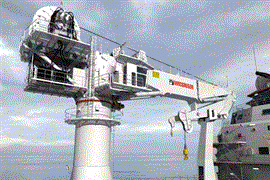Friday roundup: what’s next in offshore wind | alternative lifting advantages | cranes and the hurricanes | SPMT market growth
18 October 2024
 Hywind Scotland. Photo: Sarens
Hywind Scotland. Photo: Sarens
This week of Crane and Transport Briefings (CTB) started off by looking at what’s next in the race for ever larger wind turbines, especially in the offshore sector.
With blades as long as football fields and standing as tall as the Eiffel Tower, the lifting and logistics needed for offshore wind turbines are creating a plethora of technical challenges for the heavy lifting and specialized transport companies working in this rapidly expanding sector.
Perhaps the most challenging calculation they face, however, is trying to work out what equipment they will need over the coming years to satisfy demand for such lifts.
Lucy Barnard found out how international heavy lift and transport specialist Sarens is shaping its equipment fleet to help meet demands created as a result of the offshore wind energy industry’s evolving turbine technology and the increasingly challenging carbon emissions targets.
See how heavy lifting firms are gearing up for the next expansion in offshore turbines.
Tuesday’s CTB looked at alternative lifting solutions, especially those used for heavy loads in challenging environments, often where traditional cranes aren’t practical.
Telescopic and other gantries, strand jacks, and hydraulic skidding systems offer customised approaches for unique challenges, including limited space, irregular load shapes or even extreme weight.
These alternative methods prioritise both safety and efficiency, showcasing the evolving capabilities of specialized lifting equipment in industrial and infrastructure projects around the world.
Niamh Marriott examines some of the latest projects, including Roll Group’s modular gantry lifting 1,000 tonne loads in Indonesia and Mammoet’s zero-emission skidding method on a project in Belgium.
Read more about how alternative lifting solutions are used to tackle heavy lifting challenges.
Leading Wednesday’s CTB was a report by D.Ann Shiffler and Hannah Sundermeyer on our industry’s involvement in helping to clean up after the two recent hurricanes in the USA.
In the aftermath of Helene and Milton the southeastern United States is reeling from catastrophic damage. More than 250 lives were lost, and the states of Florida, Georgia, the Carolinas, Tennessee and Virginia will be grappling with recovery efforts for a long time to come.
Construction sites, including those with tower cranes, were severely impacted and the crane, rigging and specialized transport industries quickly mobilised to assist in the cleanup and rebuilding process.
As the region faces the long road to recovery, the industry’s expertise and resources are proving crucial in restoring infrastructure and helping communities rebuild.
Thursday’s CTB looked at how the SPMT market is being propelled by infrastructure projects, especially in North America. Self propelled modular transporter (SPMT) has catapulted in popularity among American lifting, rigging and transport companies. The market for SPMT is strong there and expected to get stronger as more infrastructure projects like bridges and power plant expansion come to fruition.
While it was originally primarily a transport mechanism, new features gave SPMT the ability to become a heavy lifter and tailing device. As components and vessels are heavier and more complicated, SPMT is used in combination with gantries, jacks and other rigging gear.
Check out the new technologies driving the market for SPMT.




